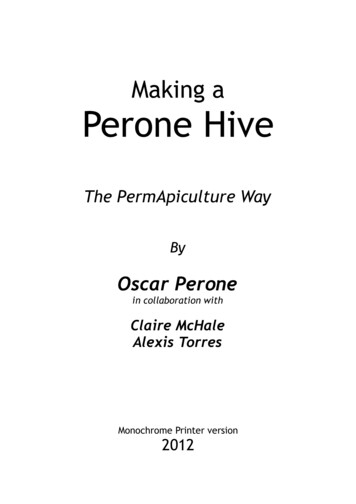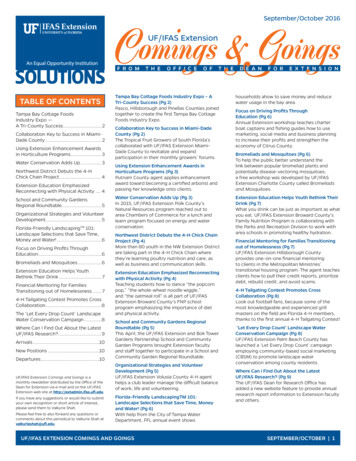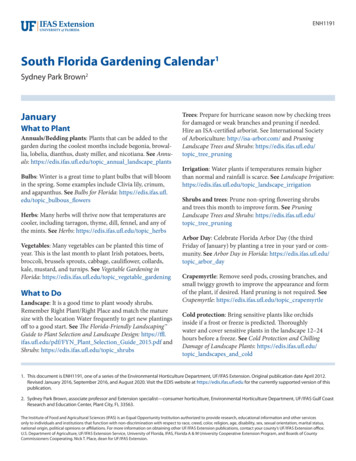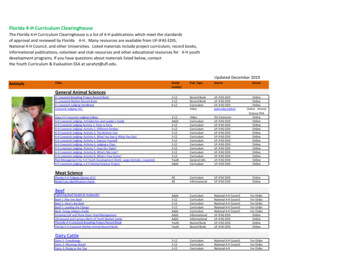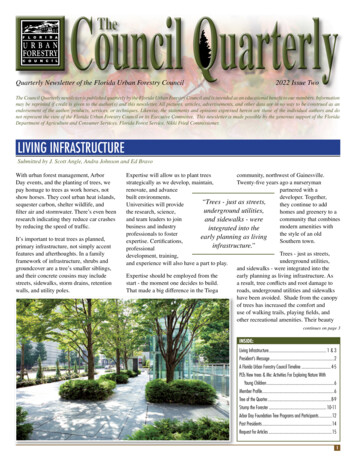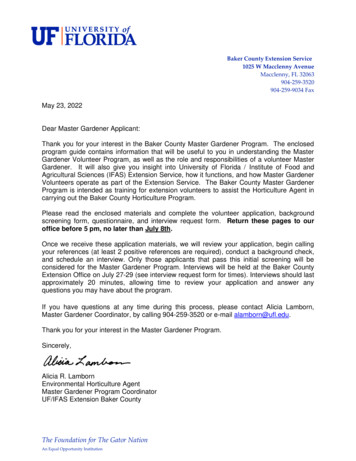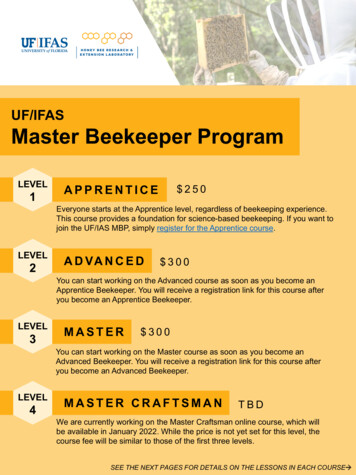
Transcription
UF/IFASMaster Beekeeper ProgramLEVEL1LEVEL2LEVEL3LEVEL4APPRENTICE 250Everyone starts at the Apprentice level, regardless of beekeeping experience.This course provides a foundation for science-based beekeeping. If you want tojoin the UF/IAS MBP, simply register for the Apprentice course.A D VA N C E D 300You can start working on the Advanced course as soon as you become anApprentice Beekeeper. You will receive a registration link for this course afteryou become an Apprentice Beekeeper.MASTER 300You can start working on the Master course as soon as you become anAdvanced Beekeeper. You will receive a registration link for this course afteryou become an Advanced Beekeeper.MASTER CRAFTSMANTBDWe are currently working on the Master Craftsman online course, which willbe available in January 2022. While the price is not yet set for this level, thecourse fee will be similar to those of the first three levels.SEE THE NEXT PAGES FOR DETAILS ON THE LESSONS IN EACH COURSE
UF/IFAS MasterBeekeeperProgramAPPRENTICELevel OnlineCourseOutlineMODULE 1: APPRENTICE LEVEL OVERVIEWLesson 1: Navigating the Online MBPLesson 2: Mission & Goals of the UF MBPLesson 3: Requirements for the Apprentice LevelMODULE 2: INTRODUCTIONLesson 1: The Importance of BeesLesson 2: Why Keep Honey BeesLesson 3: Educational Resources for BeekeepersLesson 4: Naming the BeeLesson 5: What to do About Honey Bee StingsMODULE 3: HONEY BEE BIOLOGYLesson 1: Adult Members of a Honey Bee ColonyLesson 2: Immature Members of a Honey Bee ColonyLesson 3: The Components of a Honey Bee NestLesson 4: The Life Cycle of a Honey Bee ColonyMODULE 4: BEEKEEPING EQUIPMENTLesson 1: The Parts of a Langstroth HiveLesson 2: Frames & FoundationLesson 3: Three Essential Beekeeping ItemsLesson 4: Miscellaneous Beekeeping EquipmentLesson 5: Alternative Hive Sizes & TypesLesson 6: Assembling Hive EquipmentLesson 7: Observation HivesMODULE 5: GETTING STARTEDLesson 1: Hive Choice & ConfigurationLesson 2: Starting a New Honey Bee ColonyLesson 3: The Monetary & Time Requirements of BeekeepingLesson 4: Rules & Regulations for Keeping Honey BeesLesson 5: Your Bees & Other PeopleLesson 6: Qualities of a Good Apiary LocationMODULE 6: BEEKEEPING BASICSLesson 1: Characteristics of a Healthy Honey Bee ColonyLesson 2: How to Light a SmokerLesson 3: Proper Colony Inspection TechniquesLesson 4: Installing Packages & NucsLesson 5: Marking & Clipping QueensLesson 6: RequeeningLesson 7: Basic Swarm Management TechniquesLesson 8: Making SplitsLesson 9: Feeding BeesLesson 10: Moving BeesMODULE 7: COLONY STRESSORSLesson 1: Major Arthropod Pests of Honey Bee ColoniesLesson 2: Minor Arthropod & Other Pests of Honey Bee ColoniesLesson 3: Pathogen Stressors of Honey Bee ColoniesLesson 4: Other Stressors of Honey Bee ColoniesLesson 5: Principle of Honey Bee ColoniesMODULE 8: YEARLY MANAGEMENTLesson 1: Introduction to Varroa ManagementLesson 2: Spring & Summer ManagementLesson 3: Fall & Winter Management
UF/IFAS MasterBeekeeperProgramADVANCEDLevel OnlineCourseOutlineMODULE 1: ADVANCED LEVEL OVERVIEWLesson 1: Navigating the Online MBPLesson 2: Mission & Goals of the UF MBPLesson 3: Requirements for the Advanced LevelMODULE 2: EDUCATION & COMMUNICATIONLesson 1: Backwards DesignLesson 2: Communication and Public SpeakingLesson 3: Visual CommunicationLesson 4: Teaching Youth and Adult AudiencesLesson 5: Youth Protection TrainingMODULE 3: THE EVOLUTION OF BEEKEEPINGLesson 1: Ancient Honey Bee and Human InteractionsLesson 2: The Evolution of Early BeekeepingLesson 3: The Golden Age of BeekeepingLesson 4: Beekeeping TodayLesson 5: Making Money with BeesLesson 6: Introduction to Integrated Pest ManagementLesson 7: Natural and Treatment-Free BeekeepingMODULE 4: HONEY BEE PESTSLesson 1: Varroa BiologyLesson 2: Varroa MonitoringLesson 3: Varroa ControlLesson 4: Tracheal MitesLesson 5: Small Hive Beetle BiologyLesson 6: Small Hive Beetle ControlLesson 7: Wax MothsLesson 8: African Honey BeesLesson 9: BearsLesson 10: AntsLesson 11: Minor Vertebrate PestsMODULE 5: HONEY BEE PATHOGENSLesson 1: VirusesLesson 2: ChalkbroodLesson 3: NosemaLesson 4: American and European FoulbroodMODULE 6: POLLINATIONLesson 1: Flower MorphologyLesson 2: Pollination EcologyLesson 3: Animal PollinatorsLesson 4: Bees as Super PollinatorsLesson 5: Crop Pollination by Honey BeesMODULE 7: HONEY PRODUCTIONLesson 1: How Bees Make HoneyLesson 2: Optimum Foraging TheoryLesson 3: Managing for Honey ProductionLesson 4: Monofloral and Wildflower HoneysLesson 5: Toxic and Invasive Nectar PlantsLesson 6: Good and Bad Honey PlantsCONTINUED ON NEXT PAGE
UF/IFAS MasterBeekeeperProgramADVANCEDLevel OnlineCourseOutline(CONTINUED)MODULE 8: HARVESTING & PROCESSING HONEYLesson 1: Harvesting HoneyLesson 2: Extracting HoneyLesson 3: Post-Extraction ProcessingLesson 4: Bottling HoneyLesson 5: Other Honey ProductsLesson 6: Commercial Honey House RequirementsLesson 7: Commercial Honey Labeling RequirementsLesson 8: Cottage Food Honey SalesLesson 9: Honey Shows and JudgingMODULE 9: OTHER HIVE PRODUCTSLesson 1: BeeswaxLesson 2: PollenLesson 3: MeadLesson 4: Propolis, Royal Jelly, Bee BroodLesson 5: ApitherapyMODULE 10: BEES, WASPS, & MIMICSLesson 1: Differentiating Bees from WaspsLesson 2: Common Bee GroupsLesson 3: Common Wasp GroupsLesson 4: Bee and Wasp Mimics
UF/IFAS MasterBeekeeperProgramMASTERLevel OnlineCourseOutlineMODULE 1: MASTER LEVEL OVERVIEWLesson 1: Navigating the Online MBPLesson 2: Requirements for the Master Beekeeper LevelMODULE 2: COMMERCIAL POLLINATIONLesson 1: Moving ColoniesLesson 2: State RegulationsLesson 3: Hive PlacementLesson 4: Pollination ContractsMODULE 3: PESTICIDESLesson 1: Toxicology DefinitionsLesson 2: Pesticide Impacts on Honey BeesLesson 3: Routes of Pesticide ExposureLesson 4: Pesticide RegulationsLesson 5: Understanding Pesticide LabelsLesson 6: Pesticide FormulationsLesson 7: Reducing Pesticide Risk to Pollinators in AgLesson 8: How Beekeepers can Reduce Pesticide RiskLesson 9: Recognizing and Reporting Honey Bee ExposureMODULE 4: INTEGRATED PEST MANAGEMENTLesson 1: Determining ThresholdsLesson 2: Identify and MonitorLesson 3: PreventionLesson 4: ControlLesson 5: Can IPM Be Effective for Beekeeping?MODULE 5: AFRICAN HONEY BEESLesson 1: The Origin of African Honey Bees in the AmericasLesson 2: Biology and Behavior of African Honey BeesLesson 3: Identification of African Honey BeesLesson 4: Managing AHBs and Managing Against ThemLesson 5: African Honey Bees and Public SafetyMODULE 6: HONEY BEE & COLONY BEHAVIORSLesson 1: Worker Honey Bee TasksLesson 2: The Honey Bee Dance LanguageLesson 3: Thermoregulation by Honey BeesLesson 4: Swarm PreparationLesson 5: The Honey Bee Colony SwarmLesson 6: Choosing a New Nest SiteLesson 7: Queen and Drone Honey Bee BehaviorsMODULE 7: MATING & REPRODUCTIVE BIOLOGYLesson 1: Sexual Maturation of Queens and DroneLesson 2: Drone Congregation AreasLesson 3: Honey Bee Mating BehaviorLesson 4: Post-mating MaturationCONTINUED ON NEXT PAGE
UF/IFAS MasterBeekeeperProgramMASTERLevel OnlineCourseOutline(CONTINUED)MODULE 8: QUEEN & PACKAGE BEE PRODUCTIONLesson 1: Choosing Breeder QueensLesson 2: Colony PreparationLesson 3: Queen Production TimelineLesson 4: Instrumental InseminationLesson 5: Package Bee ProductionMODULE 9: BEE REMOVALLesson 1: Bee-Proofing a PropertyLesson 2: An Introduction to Bee RemovalLesson 3: Capturing and Trapping SwarmsLesson 4: Removing Established Honey Bee ColoniesLesson 5: Best Practices After Colony RemovalMODULE 10: THE COLONY AS A SUPERORGANISMLesson 1: Honey Bee Colonies as SuperorganismsLesson 2: Food Collection, Processing, and ConsumptionLesson 3: The Endocrine System in Honey Bee ColoniesLesson 4: Colony Respiration and ThermoregulationLesson 6: Colony Immune SystemLesson 7: Colony Communication, Reproduction, and Death
UF/IFAS MasterBeekeeperProgramMASTERCRAFTSMANLevel OnlineCourseOutlineMASTER CRAFTSMAN OVERVIEWLesson 1: Navigating the Online MBPLesson 2: Mission & Goals of the UF MBPLesson 3: Requirements for the Advanced LevelCONDUCTING SCIENTIFIC RESEARCHIntroduction to Science and ResearchLesson 1: What is Science?Lesson 2: Honey Bee ResearchLesson 3: The Scientific MethodLesson 4: Research EthicsUnderstanding Published ResearchLesson 1: Navigating Published ResearchLesson 2: Finding Good Research SourcesLesson 3: Experimental Design BasicsLesson 4: Introduction to Research StatisticsConducting ExperimentsLesson 1: Establishing a Research FocusLesson 2: Experimental DesignLesson 3: Data Collection Methods in Honey BeeResearchLesson 4: Statistical AnalysesLesson 5: Communicating Research Findings to thePublicPLANNING & DELIVERING EXTENSIONPROGRAMSLesson 1: Intro to Extension Programs & AudiencesLesson 2: Determining Needs & Setting ObjectivesLesson 3: Program EvaluationLesson 4: Funding & Marketing ExtensionProgramsLesson 5: Program Plan & Learning ActivitiesTHE MASTER CRAFTSMAN COURSE IS NOT YET AVAILABLE.THIS OUTLINE IS SUBJECT TO CHANGE.
UF/IFAS. Master Beekeeper Program. LEVEL. 1. APPRENTICE. LEVEL. 2. ADVANCED. LEVEL. 3. MASTER. LEVEL. 4. MASTER CRAFTSMAN. 250. 300. 300. Everyone starts at the Apprentice level, regardless of beekeeping experience. This course provides a foundation for science-based beekeeping. If you want to join the UF/IAS MBP, simply . register for the .
